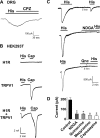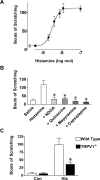TRPV1 mediates histamine-induced itching via the activation of phospholipase A2 and 12-lipoxygenase
- PMID: 17329430
- PMCID: PMC6673467
- DOI: 10.1523/JNEUROSCI.4643-06.2007
TRPV1 mediates histamine-induced itching via the activation of phospholipase A2 and 12-lipoxygenase
Abstract
Histamine provokes itching and is a major skin disease complaint. Histamine is known to excite a subset of sensory neurons, predominantly C-fibers. Although histamine is pruritogenic, its signaling pathways that excite sensory neurons have not been identified. Because the metabolic products of lipoxygenases (LOs) activate transient receptor potential vanilloid receptor-1 (TRPV1) in sensory neurons, we hypothesized that histamine excites sensory neurons by activating TRPV1 via phospholipase A2 (PLA2) and LO stimulation. In cultured sensory neurons, histamine evoked inward currents that were reduced by capsazepine, a TRPV1 blocker. Moreover, histamine provoked inward currents when histamine receptor subtype 1 (H1R) and TRPV1 were expressed heterologously, but not when H1R or TRPV1 was expressed alone. In addition, histamine caused Ca2+ influxes in sensory neurons in wild-type mice but not in TRPV1-/- mice. Furthermore, histamine caused a 2.5-fold increase in the production of 12-hydroxyeicosatetraenoic acid, a metabolite of LO, in cultured sensory neurons. When injected subcutaneously into the necks of mice, histamine caused bouts of scratching, which were greatly reduced by pretreatment with capsazepine, a TRPV1 blocker, and by inhibitors of PLA2, LO, and H1R. Furthermore, mice lacking TRPV1 markedly reduced histamine-induced scratching compared with wild type. Together, these results indicate that TRPV1 plays a key role in mediating the pruritogenic action of histamine via the PLA2/LO pathway.
Figures




References
-
- Andoh T, Kuraishi Y. Intradermal leukotriene B4, but not prostaglandin E2, induces itch-associated responses in mice. Eur J Pharmacol. 1998;353:93–96. - PubMed
-
- Andrew D, Craig AD. Spinothalamic lamina I neurons selectively sensitive to histamine: a central neural pathway for itch. Nat Neurosci. 2001;4:72–77. - PubMed
-
- Benditt EP, Bader S, Lam KB. Studies of the mechanism of acute vascular reactions to injury. I. The relationship of mast cells and histamine to the production of edema by ovomucoid in rats. AMA Arch Pathol. 1955;60:104–115. - PubMed
-
- Bickford RG. Experiments relating to the itch sensation, its peripheral mechanism, and central pathways. Clin Sci. 1937;3:377–386.
Publication types
MeSH terms
Substances
LinkOut - more resources
Full Text Sources
Other Literature Sources
Molecular Biology Databases
Miscellaneous
